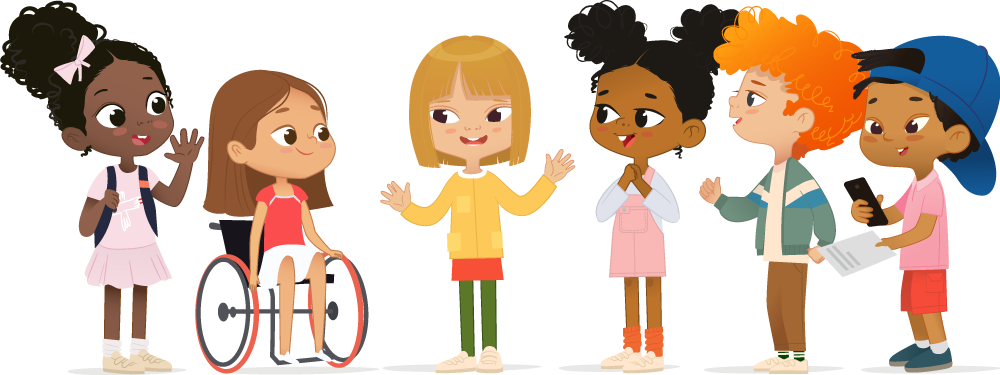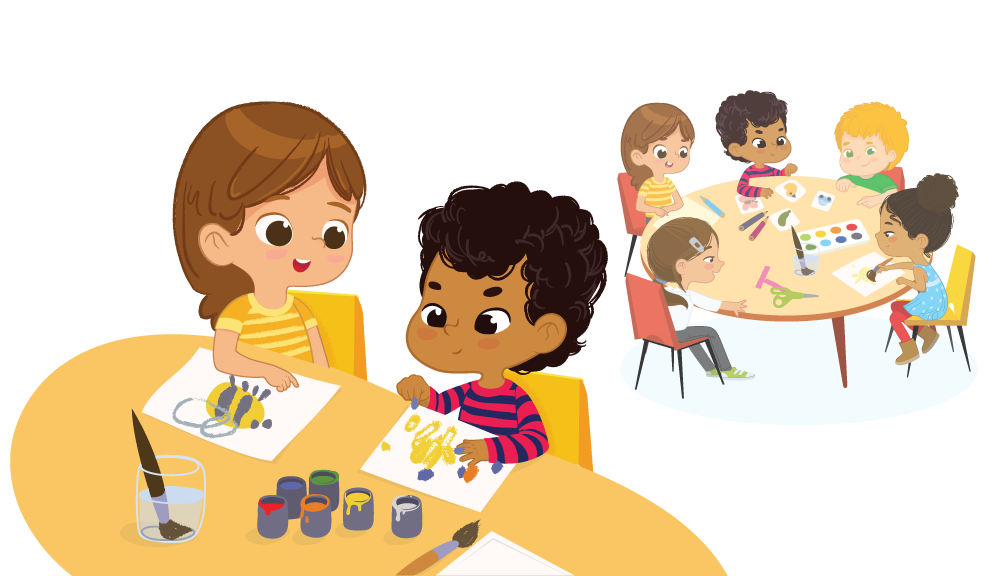3.04 | WHAT IS SELF-AWARENESS?
Self-Awareness is the ability to focus and reflect on one’s own actions, thoughts, and emotions. It is an important aspect of a child’s development. When a child becomes self-aware, they have the potential to value and appreciate their uniqueness. Once children obtain self-awareness, they can learn to respect and value diversity in others.
SOCIAL & EMOTIONAL LEARNING (S.E.L.) COMPETENCIES

SELF-CONCEPT
The ability to focus and reflect on one’s own actions, thoughts, and emotions and how they can influence decisions and behaviors
-
Identify one’s own emotions, thoughts, and actions
-
Establish an awareness of one’s own self-image and self-concept

SOCIAL AWARENESS
The ability to empathize with others who are both similar and different from oneself, recognize the value of diversity, consider and tolerate views and opinions that are different from one’s own, and understand elements and benefits of a community
-
Acknowledge the value and importance of diversity
-
Appreciate and respect others who are different from oneself
LEARNING OBJECTIVES | MATERIALS & PREPARATION

LEARNING OBJECTIVES
Children Will Be Able to:
-
Identify their current feelings or emotions
-
Determine at least one like/interest they have and at least one character trait they possess
-
Recognize the value of others who are different from oneself

MATERIALS & PREPARATION
I Am Enough by Grace Byers | Visual: My Emotions | Handouts: I Am Self-Aware - Part 1 & 2 | GlueScissors

Introduction | Duration: 5 minutes
-
Tell children that they will begin the process of developing self-awareness in this lesson.
-
Remind children that the word “aware” means to know or understand. Explain that self-awareness is the process of learning more about themselves and the person they are becoming. Tell children that being self-aware requires recognizing and reflecting on their likes or interests, thoughts, actions, and emotions or feelings. Explain that in this lesson, they will focus on identifying their emotions or feelings, likes or interests, and character traits. Tell children that character traits are words that describe what a person is mostly like on the inside.
-
Tell children that developing self-awareness is important because it helps them to value and love themselves and others who are different from themselves.
-
Tell children they will also read a book that serves as a reminder that they should love themselves and others around them despite their differences.

Reflection Circle | Duration: 15 minutes
-
Have children form a circle on the carpet. Explain to children that they will practice self-awareness by reflecting on their current emotions and why they feel a particular emotion.
-
Show children the My Emotions visual. Explain that the visual will help them name the emotion they are feeling. Review the My Emotions visual with children. Tell children that the emoji next to the picture shows or expresses what each emotion looks like.
-
Model reflecting on your own emotions. (For example, “Right now I feel excited. I feel excited because we are going to the library today, and I am eager to get a new book.)
-
Explain to children that after they reflect on their emotions, they will have the opportunity to share their emotions with a partner. Tell children that as they share their emotions with a partner, you will circulate to check in with each student. Explain that they will have the opportunity to share how they are feeling
with you and why they feel that way. -
Invite children to reflect on their own emotions. Ask children the following questions to help them reflect on their emotions:
• How do you feel right now?
• Why do you feel that way?
- Give children at least 5 minutes to reflect on their own emotions. After 5 minutes, tell children to turn to their partner, share how they feel, and share why they feel the way they feel. (If a child does not feel comfortable sharing how they feel or why they feel that way, encourage them to listen to their partner and wait silently until you can check in with them.) As children share with their partners, circulate the room and check in with each child. Spend no more than 30 seconds with each child. Dictate any notes or comments you may have for each child in the Student Observation Chart.
- After you have checked in with each child, remind children that they can request to see the school counselor if they feel like they need to discuss their feelings or a specific incident further.
- Remember to thank each child for participating in the reflection circle. Encourage children to take the time to reflect on their own emotions daily, so they can get better at recognizing and understanding their emotions.


Read-Aloud: I Am Enough by Grace Byers | Duration: 15 - 20 minutes

-
Explain to children that you will read the book I Am Enough by Grace Byers. Tell children that this book is a reminder that they should love themselves and others around them despite being different from one another.
-
Let children know that they will participate in a discussion where you will stop reading, so they can discuss what is happening in the story.
-
Begin reading the book on page 1. Continue to read each page of the entire book. Stop on the following pages to say and/or ask the statements and/or questions in the chart.
| After Reading Page | Say or Ask | Exemplar Student Response |
|---|---|---|
| 21 | The text says, “I’m not meant to be like you; you’re not meant to be like me.” Do you agree or disagree with this statement? Why?
The text says, “Sometimes we will get along, and sometimes we will disagree.” Do you think it is okay to disagree or think something different than someone else? Why do you think that? |
I agree that I am not meant to be like someone else. I think that because if we were all the same, then we would not be able to learn anything new from another. Life would be boring if we were all the same.
I think it is okay to disagree with what someone thinks. I think that because we are all different, and we are not going to think the same way. |
| 24 | We all look different than one another, and that is a beautiful thing. If everyone looked the same, then there would be no creativity and individual expression. It would be very uninteresting or boring if everyone looked and acted the same. |
|
| 25 | The text says, “But that does not dictate our worth; we both have places here on earth.” The word “dictate” means to control. The author’s message here is that the way a person looks is not connected to their worth or value. For example, curly hair is not more valuable or better than straight hair, and straight hair is not more valuable or better than curly hair. Both hair types are beautiful and belong to different people. The same idea is true for skin color, hair color, eye color, height, and sizes. No one’s looks or features are more valuable or worth more than another person’s looks or features. Turn to your partner and say, “I am valuable.” |
|
| 26 | The text says, “…we are right here to live a life of love, not fear…” The author’s message here is that no one should have to feel afraid because they look different. We should love one another even though we all look different. Why might someone who looks different from everyone else be afraid or fearful?
Is it nice to tease or make fun of someone because they look different? Why do you think that?
Teasing or making fun of others because they look different can cause that person to feel fear or be afraid to be around people who look different than themselves. Remember, all our differences are beautiful, and no one’s features or looks are more valuable than another’s. What is happening in the illustration on page 26?
Both girls look different and are different, but just because you look different from someone else, does not mean that you cannot show love toward that person. You can still be friendly, nice, kind, and giving towards someone who looks different than you. How is the little girl in the blue dress showing love toward the little girl in the pink dress? |
They might be afraid that others will make fun of them or tease them because they look different than everyone else.
It is not nice to make fun of someone or tease someone because they look different. I think that because making fun of someone would hurt their feelings and make them feel bad about themselves or the way they look.
The girl in the blue dress is giving the girl in the pink dress a flower.
She is showing love by giving her a flower. |
| 28 | What are the children doing in the illustration on pages 27 and 28? Do you think the children on pages 27 and 28 are friends? Why do you think that?
Although the children on pages 27 and 28 all look different—they have different skin colors, hair colors, eye color, different heights, and sizes—they are still kind to one another. Do you think you could be friends with someone who looks different than yourself? Why do you think that? |
The children are holding hands, standing, and sitting together. I think the children are friends. I think that because they are holding hands and standing together, and I know that friends usually stick together or are always around each other.
I know that I could be friends with someone who is different from myself. I think that because we all are different from one another. It does not matter how someone looks; it matters that you enjoy talking and having fun with your friends. |
| 29 | Turn to your partner and say, “I am enough.” Now affirm or encourage your partner and say, “You are enough.” |
If I were Millie’s friend, I would teach her to take deep breaths when she is angry/frustrated; I would teach her to talk to a trusted adult about her anger/frustration; I would teach her to draw or color a mandala, so she could calm down and feel better. |

Independent Work Time: I Am Self-Aware | Duration: 15 minutes
-
Remind children that developing self-awareness requires recognizing and reflecting on their likes or interests and character traits. Tell children that a character trait is a word that describes what a person is mostly like on the inside.
-
Give each child an I Am Self-Aware – Part I & 2 handout, scissors, and glue. Read the directions located on the I Am Self-Aware – Part I handout.
-
Show children your completed I Am Self-Aware – Part 2 handout. Explain that the top of the picture has the name of the activity, and the bottom of the picture has a character trait that matches the activity. Tell children that if they are someone who enjoys playing sports, then they are most likely a team player or someone who enjoys working with others. Read the completed sentences of your example. (For example, I like to read and ask questions, tell jokes and laugh, and color and paint. I think I am curious, funny, and creative. Explain that curious, funny, and creative are your character traits.)
-
Explain to children that they will cut out one, two, or three pictures that contain the activities they like to do.
-
Tell children that after they cut out the pictures that contain the activities they like to do, they will glue each picture in the boxes located on the I Am Self-Aware – Part 2 handout.
-
As children work, circulate the room to help children read the sentence stems after they have completed page two of the activity. Let children share their completed activity with a partner if time permits.

LESSON PLAN DOWNLOADS
SUPPLEMENTAL ACTIVITIES & MEDIA
Supplemental Activities & Media








